By Chris Becker
Here’s my roundup of what happened in major macro markets in the last week and what could happen in the weeks ahead as the world’s central bankers continue to apply the “milkie wilkies”.
Remember, the following views are my own, do not constitute advice and are for information purposes only. I may have positions in any or all of the below and their associated markets both long and short, on an intra-day, daily and weekly basis for my own account. Please seek advice from a licensed adviser before making any investment decisions.
Currencies and Gold
The best way to measure or gauge currencies is through the US Dollar Index (DXY) which is made up of a basket of major currency pairs against the USD. Since the GFC (Great Recession) it has been the major “risk on/risk off” indicator, with a lower USD usually meaning higher risk as US stock markets rise and push other risk assets higher, such as our own share market. But there has been a shift, as witnessed by the decline in the “undollar” currency, gold, which I’ll cover shortly.
Starting with the weekly chart you can see that in comparison with QE2, where the DXY declined some 12%, QE3 – if measured by USD weaknesss – has not been successful at all as the currency wars continue. The DXY continues its break out above resistance at 81.5 points and well above its 200 day moving average (the red line in all charts) and possibly on its way to 84 or even 88 points:
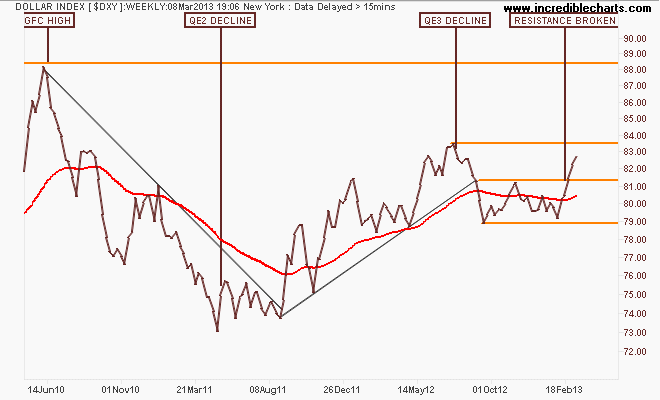
On the daily chart, this past three weeks have seen the USD strengthen considerably (or more appropriately the other currencies weakening), and its downtrend since QE3 completely broken. The shorter term target here is around 84 points, which seems a given since the ECB and JCB are on the warpath:
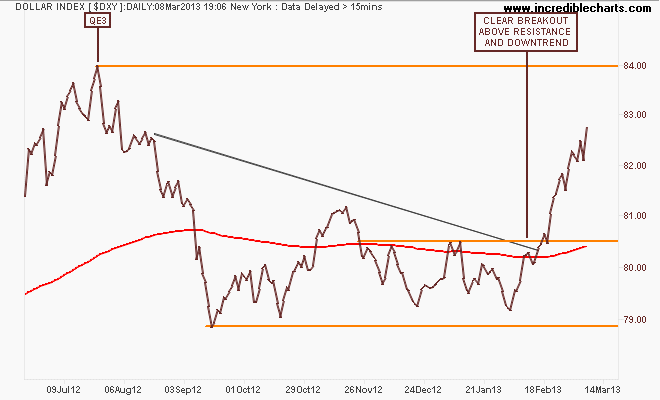
Because of its composition, the general opposite of the DXY is the euro (EUR/USD). After its break of the year plus down trend in August last year, the euro had broken out above resistance (former support) at the 1.31 level on the weekly chart. It continued this trend, before becoming overbought, but still staying on trend. With this reversal below support and the 200 DMA, we could see the euro falling considerably:
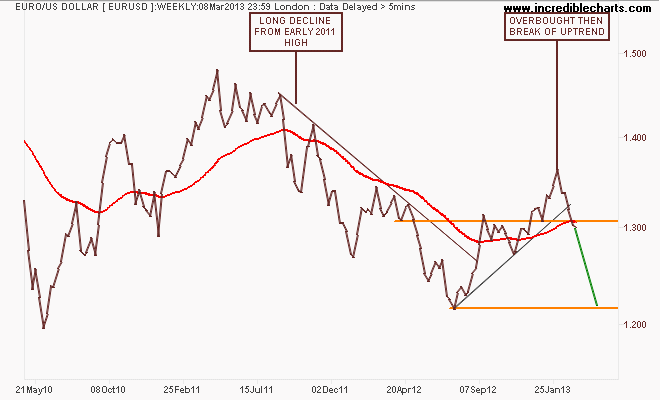
Here’s the shorter term picture with an obvious channel between resistance at 1.32 and support at 1.28, where in the past week we’ve seen considerable rejection of resistance above:
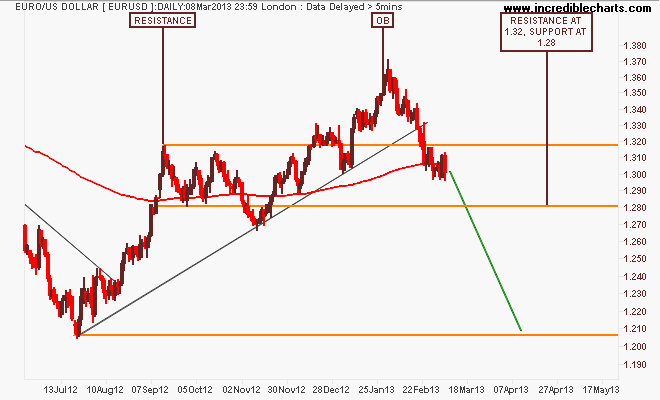
Thought it might be time to talk about the Yen (USD/JPY) again, with the JCB and government (but I repeat myself, they’re effectively the same now) mandating targets for the Nikkei and Yen. First, here’s the longer term view, with the descending triangle (a weakening USD) in the years leading up to the GFC, the safe haven run post-GFC, and now “the greatest monetary experiment in human history”:
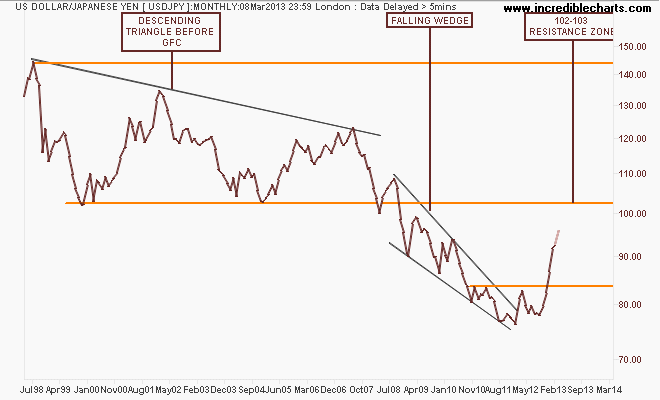
Here’s the weekly chart showing the bottom at the end of 2011 and a false breakout before this almighty surge:
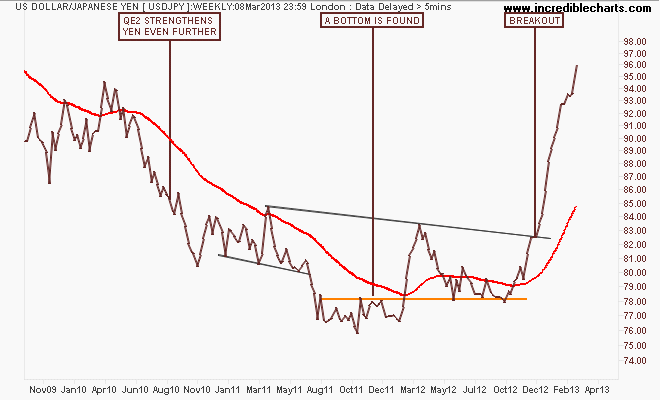
This week saw egg on the face of those who thought the yen was overbought and couldn’t go up another notch. I think its pretty clear that central banks rule markets (for now). Don’t fight the milkie wilkies! A clean breakout above 94.5 and we’re off again. The target overhead could be 100, 120, 140 or 150….or, if you’re Hugh Hendry, 60 then 200!
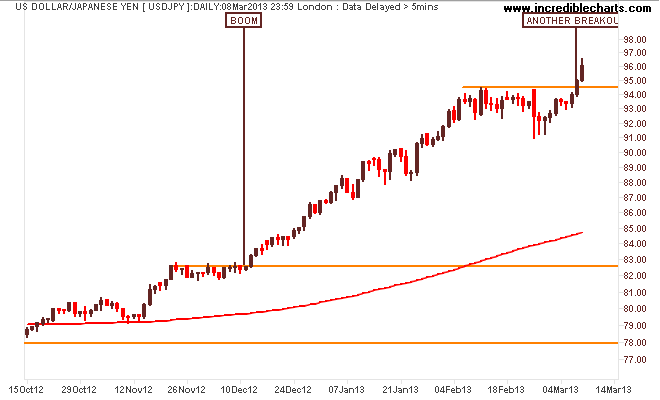
Last week I questioned if the Aussie “battler” (AUDUSD) had finally broken its 3 year uptrend from the pre-QE2 low. So far this week I’ve been wrong, although the weekly chart below shows a deflating series of lower highs from the mid-2011 highs, the current price using either high/lows or closing prices shows the trend remains intact.
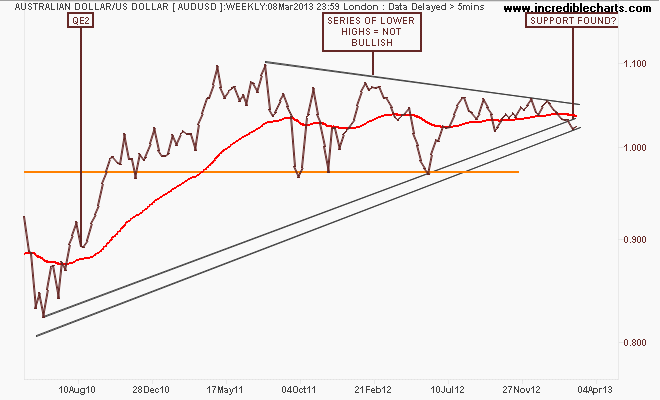
On the daily chart its fairly obvious there is tremendous selling pressure from above (or lack of buying pressure) with the battler retracing to the 1.02 level and well below its 200 day moving average. But this week, following the RBA’s decision to hold rates, the battler found tremendous support (notice the “pin” on Tuesday)
A small rebound has seen the Aussie approach 1.03, but I think its a big stretch to call this a bottom. As the current easing cycle remains in limbo, and the USD remains strong, the most likely outcome is rangebound between 1.02 and 1.04. In other words, still time to do online shopping until 3Q and 4Q when I contend we will no longer quote AUD with a 1 in front of it…
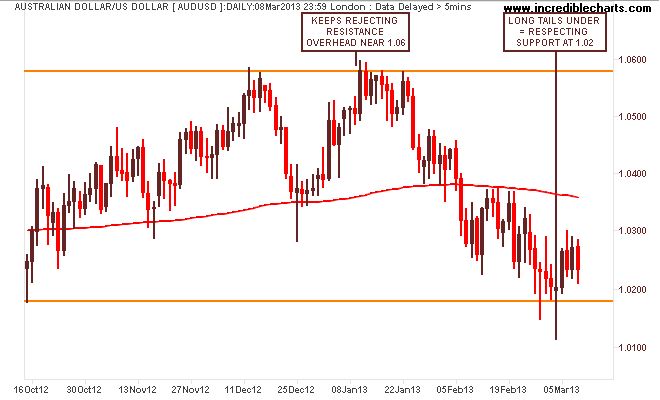
I’ll finish the currency section with the undollar currency, gold (USD). The main precious metal (I also trade silver, palladium and platinum) continues to confound the gold bugs and bears alike, but USD strength is weighing against. Here’s the weekly chart where price remains right on the nearly 2 year support level at $1560 per ounce:
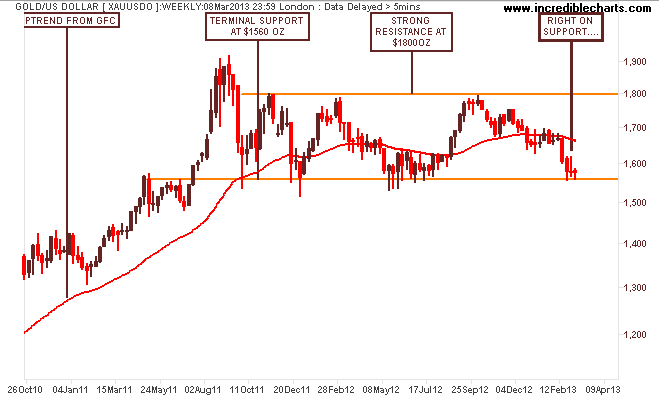
The daily chart paints many different pictures, depending on your bent. A long term speculator in gold will probably see the best time to buy in nearly 2 years. A countertrend/swing trader – a good time to buy on stretched lows. A shorter of gold: a good time to wait and see if gold can break support… My MACDH setting is showing obvious bearishness, but the intraday support with long tails below the candles does point to a possible rebound:
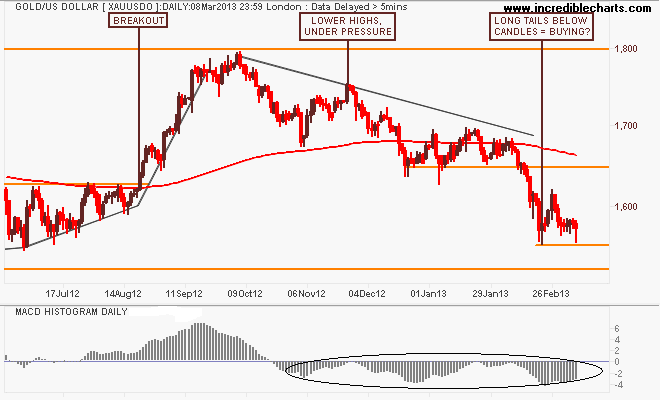
Commodities
For Australian investors particularly, there’s three major commodities to watch: crude oil, copper and iron ore. I’ll leave the last to Houses and Holes with his excellent daily updates (although it’s non tradeable for retail/private investors – Fortescue Metals (FMG) and Atlas Iron (AGO) are excellent proxies, both of which I trade regularly), but crude oil and copper are great barometers displaying both real demand and US dollar strength/weakness.
And there’s reason to be concerned that the enthusiasm in equity markets is not being matched by the commodity complex.
First, lets take a quick look at the WTI Crude marker, which is moving nowhere with USD strength weighing:
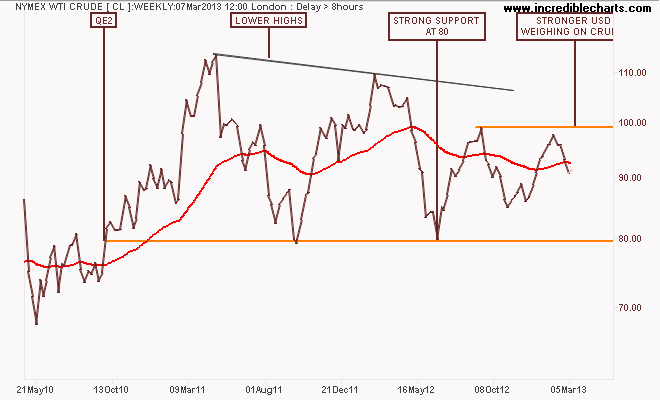
Then, ICE Brent Crude, with the weekly chart of the spot price showing a false breakout above resistance at $117 per barrel which has retraced to the middle of its channel. This is similar to WTI Crude, although more volatile (hence why I prefer trading it) it too is going nowhere:
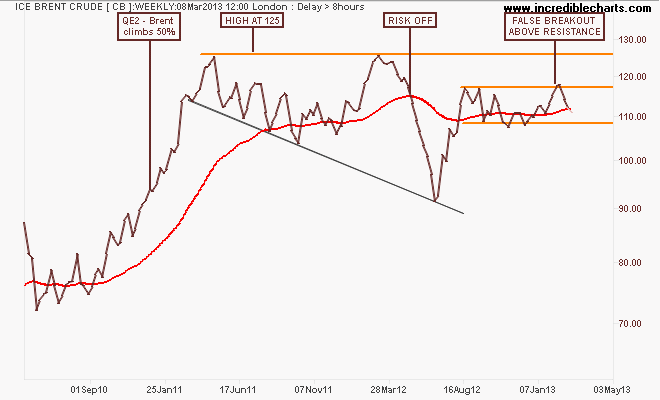
Copper is the other significant market that is facing more resistance over head than Brent and indeed looks very weak here on the weekly chart, but the uptrend from the mid-2011 lows remains intact. Again, not much to talk about here, with the big Monty Python foot called the USD pushing all of these markets down….for now
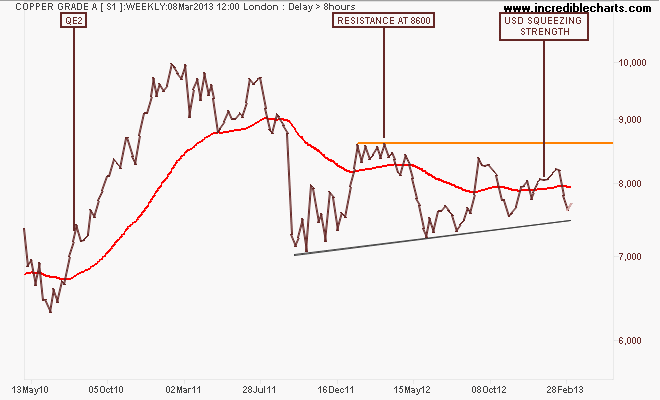
Risk and Volatility (no I’m not repeating myself, they are different!)
Now to stocks, actually first the VIX, remaining at pre GFC “everything is fine” levels:
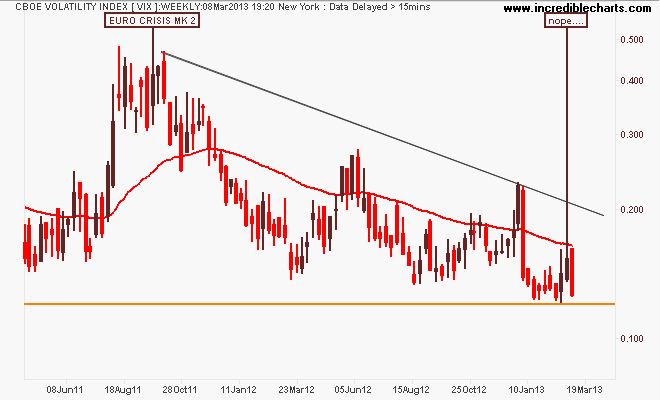
There’s no need for a daily chart (which I view each night/morning as part of my routine as it effects my position sizes and contingency plan) just look at that red weekly candle! Fuggedaboutit….buy the dip.
Before I look at US stocks, let’s have a quick review of Chinese and Japanese equity markets.
The Hang Seng China Enterprises Index (HSCEI – my preferred market to the Shanghai Composite), after some volatility around the tightening of property speculating rules is rebounding again, well above its 200 DMA and on its way to hit its 11800 resistance level:
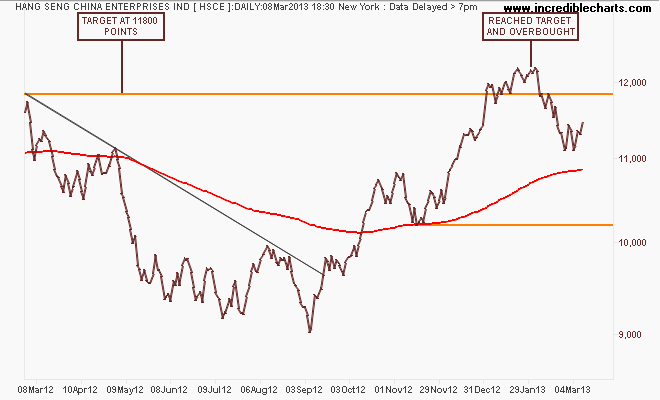
Similarly, there’s nothing stopping the Nikkei 225, punching through its post-GFC reflation high and on its way to its mandated target around 13000-14000 points, with the weakening yen driving these “fundamentals”. Cough.
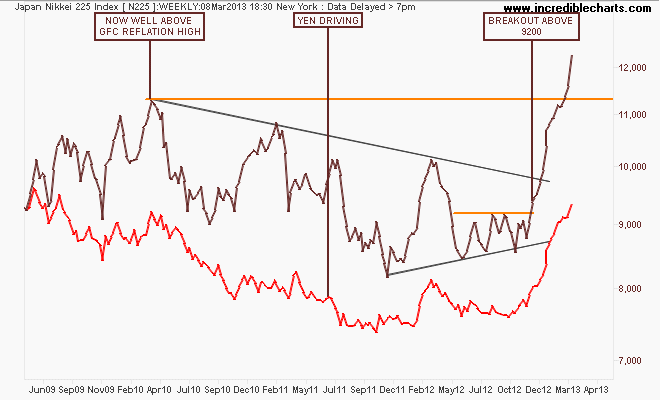
The US S&P500 index broke my target of 1550 points last night on the back of “good” NFP figures, now reaching its historic pre-GFC high. I remain very concerned that this represents a similar mood to the blowoff rally in 2007, with an increased likelihood of a pull-back or correction to the lower trend line down to 1400 points or so. Here’s the monthly chart of the 13 year long secular bear market in US stocks:
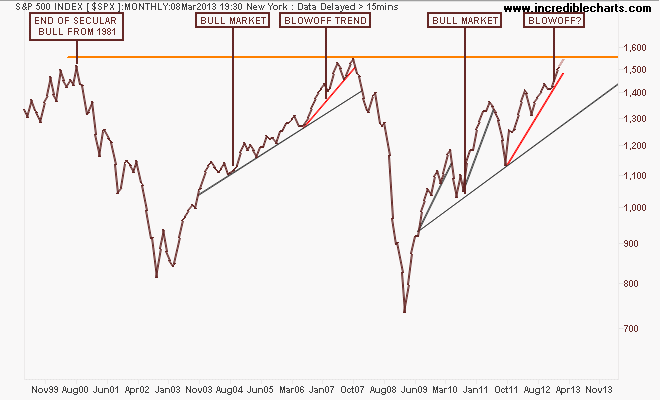
The weekly chart below shows how the series of higher highs is smaller on each up cycle and again is forming a rising wedge pattern (where the higher highs are not same magnitude of the higher lows), which is supposed to be very bearish. But this is a “new normal”, a “permanently high plateau”. Where else are you supposed to put all this liquidity?
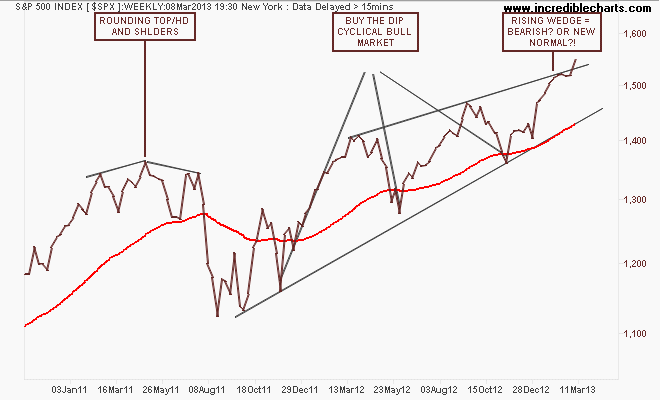
Just BTFD, I’m no longer short and am back to being long (with the very smallest of positions!)
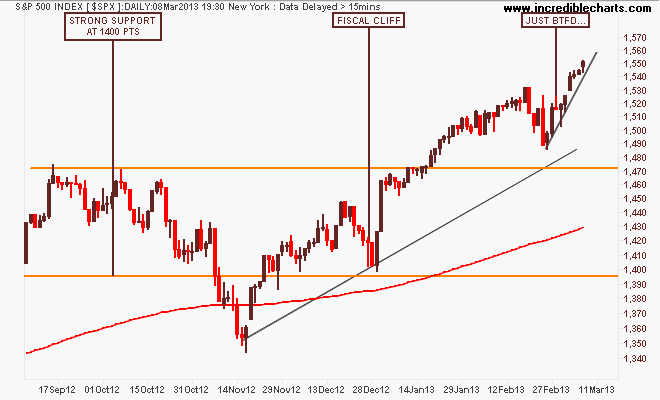
Whilst US markets have had 13 years in a secular bear market (defined as a market that fails to break its previous historic high), the local S&P/ASX200 index is halfway through in my opinion. While it is now obviously in a cyclical bull market, there are several things to note in the monthly chart below.
First, the key levels at 3800-4000 (strong support), 4400 (intermediate resistance and the outer edge of the index’s real value), 4900-5000 (strong resistance) and 6850 (the former high of the 2003-2007 bubble):
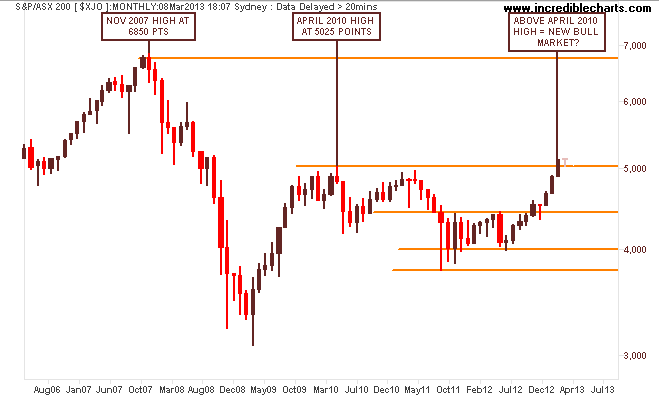
Before we go further, check out the above chart matches this chart from a Morgan Stanley study that shows how our current market is going right according to historical guidelines. We’ve had the rebound rally, a major correction (2011), and now we are in a trading range with cyclical rallies and corrections. My opinion is we are likely to have a similar triple top pattern to the end of 2009 (a series of small corrections and counter rallies) throughout 2013 as this cycle has been far too quick:
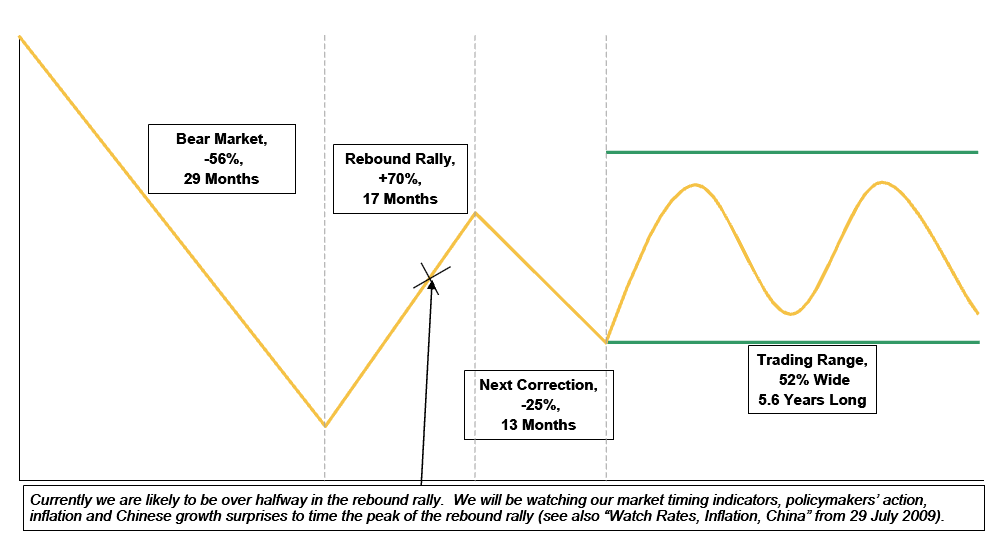
The weekly chart is the clear definition of overbought. You do not have 13 plus straight weeks in a row without a correction of some nature. Unfortunately, market participants expect more of the same when the same has been good. There’s heaps of support at 5000 points here:

I previously suggested that a sizeable correction back to 4600 points would provide greater strength for a rally to break through 5000 points and further this year. Here is my technical target, based on a Fibonacci retracement of the GFC top and bottom. The 5000 point level is the 50% retracement, with the 61.8% giving an overhead target of 5400 points.
It’s fairly obvious that to achieve this target (or even higher) requires a slightly more sedate trajectory, which means we will have a correction in the coming weeks and months. The question remains is that a good time to take profit, or load up again?
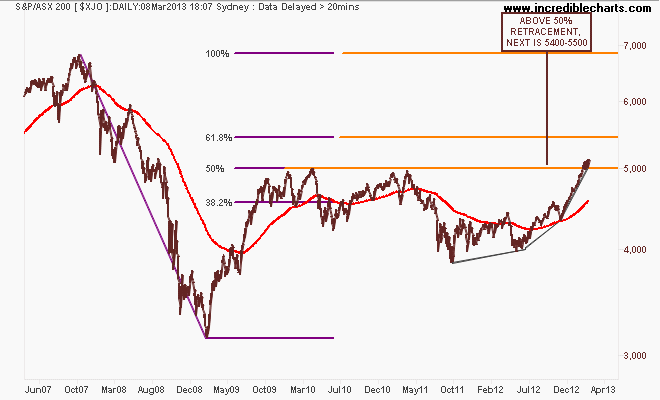
And finally the real reason why this market is going nuts: Megabank – the 42% monster of the index – which remains in a major parabolic uptrend for a variety of reasons (fear being the main one – fear at missing out on yield). The finance sector is now well above its reflation high in 2010, but well below its GFC high….and yes, that’s a semi-log chart below. Looks worse (or better, depending on your point of view) on a linear chart!
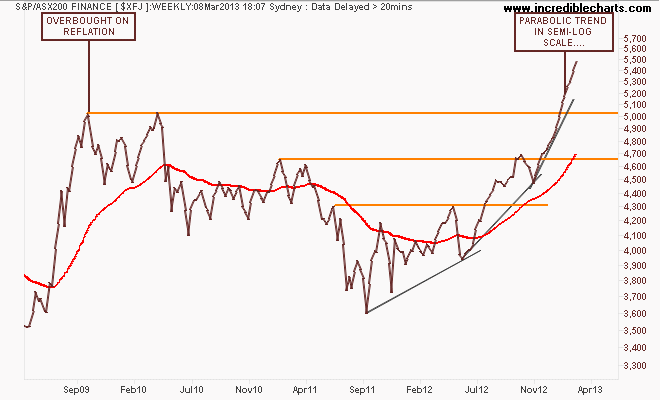
That’s all, remember to manage your risk first and the returns will come thereafter. See you next week and stay safe.
